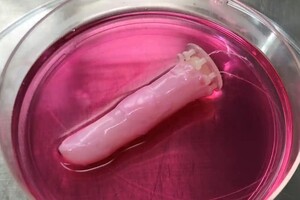Thus, researchers want to “build new relationships between people and robots.”

Japanese scientists have created a “slightly sweaty” robotic finger , covered with “living skin”. According to researchers, this could take the relationship between humans and robots to a new level, according to The Guardian. However, researchers are divided over whether people will like the realistic anatomy of the finger or they will find it scary.
Read also: Scientists have created a robot rat that can look for people under the rubble
>
Lead author of the study, professor of the University of Tokyo Sedji Takeuchi, admitted that the creation of the finger is only the first step towards creating robots covered with living skin. The research team is confident that more realistic humanoids will be able to interact more naturally with people in various fields, including services and care.
“I think living skin is the perfect solution that allows robots to look and feel like living things, because it's the same material that covers animal bodies,” Takeuchi said. He added that such advances could “build new relationships between people and robots.” But researchers have been working hard to create living skin on three-dimensional dynamic objects.
In this study, the team dipped a robotic finger into a cylinder filled with a solution of collagen and human dermal fibroblasts, the two main components that make up the connective tissue of the skin. They covered the surface of the finger like a primer for staining, providing a seamless layer for the next layer of cells – human epidermal keratinocytes – to stick. Flexion of the finger led to the appearance of natural wrinkles on the joints, and during the injury, artificial skin can repair itself, as well as human skin. Scientists claim that their creation feels like human skin.
But the finger is still under development, the skin that covers it is still thinner than a human. In addition, it must be kept moist, because without the circulatory system, cells will die if they dry out. The movements of the finger are also clearly mechanical.
“The finger looks slightly sweaty right from the nutrient medium. As the finger moves with the electric motor, it is also interesting to hear the clicking sounds of the motor in harmony with the finger, which looks very real, “said Takeuchi.
known as the “ominous valley” effect. This effect suggests that a robot or other object that looks and acts more or less like a human, but may not be disgusting or disgusting to people who come in contact with it.
Previously Amazon has introduced the home robot Astro, which runs under the voice assistant Alexa . The robot can supervise pets and the safety of the house while the owners are away.




